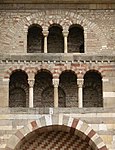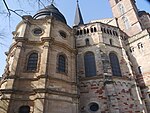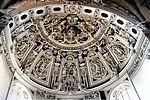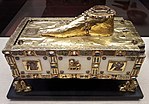Trier Cathedral
| Trier Cathedral | |
|---|---|
| High Cathedral of Saint Peter in Trier | |
Cologne | |
| Diocese | Trier |
| Clergy | |
| Bishop(s) | The Rt Revd Dr Stephan Ackermann[1] |
| Provost | Werner Rössel[2] |
The High Cathedral of Saint Peter in Trier (
History
According to certain sources, the cathedral was commissioned by Emperor
The fourth-century church was left in ruins by the Franks but rebuilt. It was destroyed again by the Vikings in 882. Under Archbishop Egbert (d. 993) rebuilding started, completed by Poppo of Babenberg (1016–1041). The famous west façade dates from this period, although the apse was not finished until 1196. Throughout the centuries the church continued to be rebuilt and embellished, according to the fashion of the period with Gothic vaults, Renaissance sculptures and Baroque chapels, but the overall style of the building remains Romanesque with a Roman core.
Description
Exterior
Large sections of Roman brickwork are visible on the north façade. The imposing
-
Roman brickwork at the north façade
-
Westwork with four towers
-
Detail westwork in Salian style
-
East choir and Chapel of the Holy Tunic
-
Coat of arms of Johann Hugo von Orsbeck, from 1676 to 1711 Archbishop of Trier
Interior
The interior measures 112.5 by 41 meter. It consists of three largely Romanesque naves with Gothic vaulting. The original Roman structure is difficult to read on the inside but its basic rectangular form may still be recognized in the three easternmost bays of the nave. The four original columns were reused in the 11th century but changed into cruciform piers.[6] A Baroque chapel for the relic of the Seamless robe of Jesus, recovered from the previous main altar in 1512, was added behind the east choir and is visible through an opening in the wall. The west choir is also decorated in the style of the German Baroque, and so are the chapels of Our Lady and the Holy Sacrament (with the "Golden Gate", part of the former rood screen), and most of the altars in the church. A Romanesque tympanum depicts Christ with the Virgin Mary and Saint Peter. The main church organ appears old but dates from 1974.
-
Interior view towards the west
-
Baroque west choir ceiling
-
Golden Gate
-
Church organ
Burials
- Henry I, archbishop of Trier († 964)
- Udo, archbishop of Trier († 1078)
- Baldwin, archbishop of Trier († 1354)
- Bohemond II, archbishop of Trier († 1367)
- Richard von Greiffenklau zu Vollrads, archbishop-elector of Trier († 1531)
- Lothar von Metternich, archbishop-elector of Trier († 1623)
- Johann Hugo von Orsbeck, archbishop-elector of Trier († 1711)
- Franz Georg von Schönborn, archbishop-elector of Trier († 1756)
-
Greiffenklau Altar, 1531
-
Metternich Altar, 1623
-
Orsbeck Altar, 1711
-
Schönborn Altar, 1756
Treasury and relics
The
-
Skull of St. Helena
-
Egbert Shrine
-
Holy Nail Reliquary
Cloisters
The Gothic
-
Cloister yard
-
Cloister corridor
-
Traced window
-
Statues of bishops
Bells
The cathedral has 10 ringing bells in total, all hung in the South Tower, all cast in 1949 by the Otto bell foundry in Bremen-Hemelingen. The largest bell or
See also
- Roman Monuments, Cathedral of St. Peter and Church of Our Lady in Trier UNESCO World Heritage Site
- Liebfrauenkirche, Trier
References
- ^ "Personen & Kontakte: Der Bischof (People & Contacts: The Bishop)" (in German). dominformation.de.
- ^ "Das Domkapitel (The Cathedral Chapter)" (in German). dominformation.de.
- ^ ISBN 90-74252-04-4
- ^ "Roman Monuments, Cathedral of St Peter and Church of Our Lady in Trier". UNESCO World Heritage Centre. United Nations Educational, Scientific, and Cultural Organization. Retrieved 28 May 2022.
- ^ "In the twelfth century many of the Meuse-valley churches were rebuilt [...] For these latter buildings the great churches of Rome, Jerusalem, Aachen and Trier, that had already been so important in the tenth and eleventh centuries, lost nothing of their importance." Den Hartog (1992), p. 56.
- ^ Den Hartog (1992), p. 89.





















